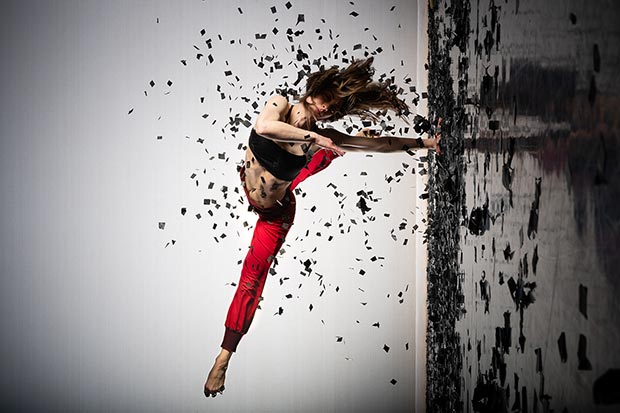
© Steve Tanner. (Click image for larger version)
James Wilton Dance
The Storm
★★★✰✰
London, The Place
23 November 2018
www.jameswiltondance.org.uk
theplace.org.uk
James Wilton returns to The Place with his new work, The Storm. This grapples with feeling low, becoming depressed and the tempest like outbursts which can follow. Different troubles flow through the veins of his three leading dancers: the four supporting performers might be their distress visualised and made flesh. It’ a promising idea and there are some very talented dancers involved, but it might have been more powerful if it had been shorter. It runs to just over ninety minutes, including a fifteen-minute interval. Trimmed to sixty minutes straight through would have given it greater impact. That might be a minority view: the audience clearly adored it as it was.
The stage at the Place is completely bare, with only the lighting (by Alan Dawson) and Wilton himself to provide a framework for the dance. The seven dancers are in ordinary street clothes, fortunately in bright colours to make them visible against the blackness. The work begins with the three protagonists (Norikazu Aoki, Sarah Jane Taylor, Ihsaan de Banya) looking relaxed and cheerful, gently interlacing their arms. It doesn’t last. Each of them in turn seems assailed by a physical tic that embodies a mental trauma.
For Sarah Jane Taylor it begins with a trembling in her right hand: she grabs it like a foreign object that doesn’t belong to her and tries to hide it away. The tension rises in her shoulders. De Banya, an imposing figure who you might remember from his work with Richard Alston Dance Company, seems to be a comforter, trying to help and sooth. He plays this role again as Norikazu Aoki becomes increasingly agitated, possessed, struggling to crawl across the floor to an elusive puddle of light. But here De Banya’s role seems more ambiguous: is he trying to stop Aoki from harming himself or is he one of those friends who think they are helping by curtly telling you to pull yourself together when you are on the floor in tears? Aoki is remarkably fluid and boneless, melting to the floor only to spring up onto his hands without apparent effort.
In each of these episodes, a crisis can quickly blow up, introduced by crunching blasts of noise on the soundtrack provided by Amarok (Michal Wojtas). Wilton’s works have previously been accompanied by very loud music, so loudness was not unexpected, but the sudden sharp explosion of decibels still comes as a shock. Here Wilton has his four supporting dancers flinging themselves across the stage, leaping, rolling, back-flipping, in squalls of furious abandon. The unhinged energy transmits itself to the rest of the cast.
Wilton’s dance language is athletic and forceful, brutal even, with a range of influences in the mix including martial arts and break dance. Dancers throw themselves recklessly through twists in the air before collapsing to the floor. The movement is fast and fluid. There’s little differentiation in the language for the sexes in terms of jumping, supporting and lifting, but the three lead performers all have their distinct vocabularies. There is an interesting duet in the second half for Taylor and one of the men where they twine their arms around each other, but can never quite bring themselves to touch, and which has a welcome delicacy. Given the length of the piece though, repetition of gesture and motif becomes increasingly apparent.
The work comes to an end in a shower of scraps of paper falling from above, giving us the storm of the title. When that’s done, are the protagonists cured of their troubles? It looks more like a state of truce than peace.
Splitting the work into two sections did it few favours. The first half seemed overlong at fifty minutes and the second a bit short at about twenty-five. There was no obvious logic to the division, and it took a while after the break to build up the same head of steam. There were some fine committed performances here, with Sarah Jane Taylor particularly expressive in her uncertainty and insecurity. But it wasn’t as moving or involving as Wilton obviously intended it to be. The dancers hurl themselves about the stage with fearless energy and the audience responded to this with great enthusiasm at the end. But it had been a meandering journey without a clear outcome.












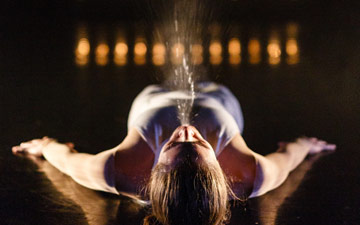
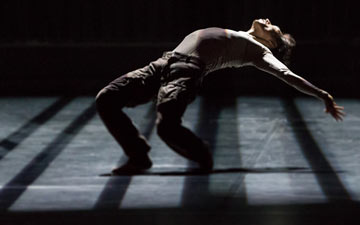
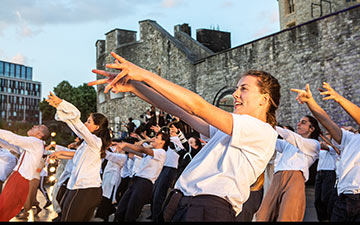
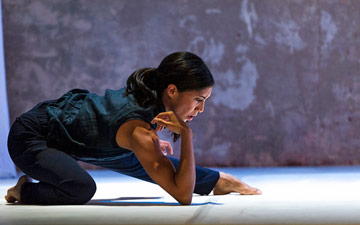
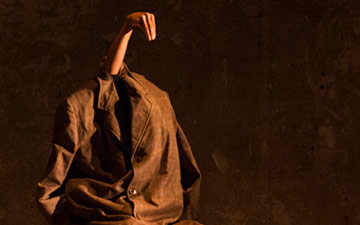
Spot on, Lynette! I attended it on both Friday and Saturday and was left with the exact same impression. The technique was spectacular, not just the principals’, but everyone’s; that’s why I went again on Saturday.
But in terms of emotional connection, there was none of that. Halfway through in the first part repetition was creeping in. Was confused on what it was trying to convey. Had the same last year when I saw Leviathan, again at The Place.
I am an amateur contemporary dancer and trauma survivor so I was really looking forward to this, but was left cold. Yet I was blown away by the prowess of all dancers.